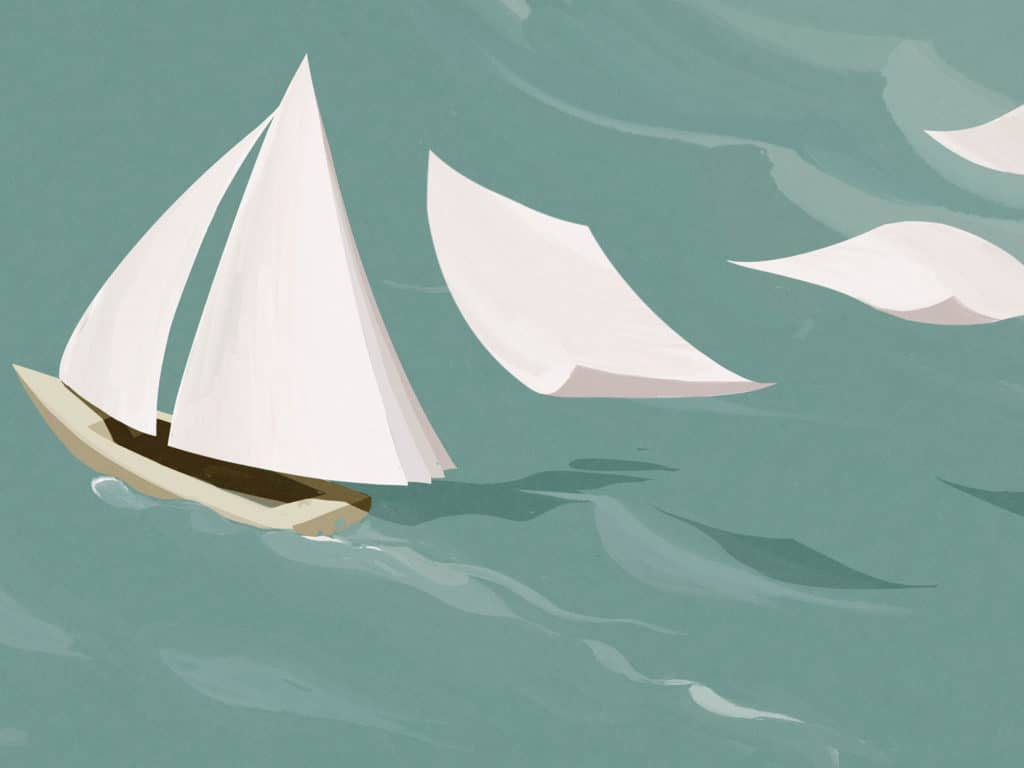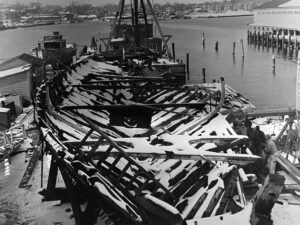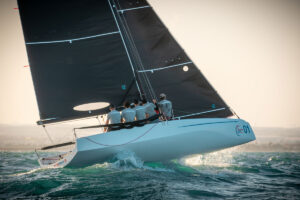
A surreal emotion sweeps over me as I peel back the stiff canvas cover, exposing my Interlake to the warm July morning sun. The routine of rigging my boat before the day’s race will be the same as it’s always been, but this time, the experience will be different. Dad is no longer beside me, meticulously preparing the boat as he always did, checking control lines for chafe, inspecting every bit of hardware and gliding his hands over the foils to confirm their perfection. That’s how we would rig my Interlake together—until 2012, when cancer suddenly took him.
It’s amazing how a simple sound can extract a memory from deep within. When I hear water slapping the Interlake’s flared bow, its hard chine sluicing through a choppy Sandusky Bay, just as it was designed to do, I think of Dad.
It’s also a sound that draws the happiest memories of sailing with my family, of junior sailing practices and the laughter, fun and freedom of being a carefree teenager on the water. It’s a sound that has bonded me to the Interlake for decades.
Like many of us, I was lucky to discover sailing through my parents, both of whom were outstanding sailors with a genuine love and passion for the sport. Dad won a handful of national championships in the Columbia 26 and Tartan 10 classes. He was calm on and off the water and had a knack for making the boat go a touch faster than any boat around him. I crewed for him for many years, unknowingly soaking up his lessons and wisdom.
When I was very young, I would sit behind Dad during windy races on Wine Squall, the family T-10.
This was the safest spot on the boat for a child, and it allowed me to have the perfect seat to watch him drive through the waves. Dad’s best friend, Jack Mueller—who was always the main trimmer in any large regatta we ever sailed—was also a great teacher, a very accomplished sailor, and class builder for many years for the Lightning and Snipe classes. He was also a man who graced any room he entered with a legendary smile and laugh.
Jack shared the same calm demeanor as Dad, making them a great combination. I learned a great deal watching them sail together over the years.
As I grew older, I was given the opportunity to move forward in the boat, from behind the tiller, to trimming the jib, to even sharing the helm with my father during the North Americans. He and Jack worked well together, always reminding the team that boatspeed was essential, but sailing on the correct side of the course was always more important.
They shared the same perspective that winning was great—but not as important as enjoying our time on the water together. They both had a great feel, and they taught me a great deal when it came to sailing in waves. They were always discussing heel angle, traveler height and how the bow felt going through the chop.
They also had the great ability to forget a poor result, and follow up a bad race with a strong finish to save a series.
RELATED: My Class, My Story: Capri 25
My parents enjoyed sailing together and to make a point of it, they always registered as George and Nancy Ward in any major regatta they ever entered, a tradition my wife Jayme and I continue to this day. In their honor, the T-10 class now awards the Ward Trophy at the annual North American Championship to the top placing husband and wife team.
Sportsmanship was always very important to my father too. He viewed sailing much like running a business: If you treat people with respect, act honestly and avoid conflict whenever necessary, you will generally come out on the winning side of things. After his passing, the Sandusky Sailing Club graciously honored my dad by naming their annual sportsmanship award after him. One of his best friends, Rex Carper, a legendary bowman for many years on Wine Squall, designed and donated a beautiful trophy.
After graduating from college long ago, I found myself looking for a place to settle and a small boat I could campaign on my own. The Sandusky Sailing Club in Ohio was an obvious choice. The dry-sail area at the club was forever teeming with Interlakes, which the club commissioned in 1933, and the local fleet, with as many as 40 boats at the time, was an active group.
The Interlake was the work of Francis Sweisguth, who also designed the Star. Sweisguth was hired to develop a centerboard dinghy uniquely designed for Lake Erie’s Sandusky Bay.
Eighteen feet long, easy to trailer, rig and sail, it was the perfect boat for the club. Its bow glides easily through the tight chop that we often have on the bay and the right amount of heel angle greatly affects how the boat performs, in flat water or waves.
My first Interlake was an older model, which I raced for a few years. It was a good boat and I had a great time learning more about the class and what would be required of me to race at a higher level.
Every year, the week before the national championship, Dad and I would get together, go over the boat and make sure it was ready for the regatta. He was a believer in setting up for success before leaving the dock for the first race, so he instilled in me one key element of sailboat racing: If my equipment, rigging, sails and crew are in order, I have no excuse to lose.
One appealing trait of the Interlake is its simplicity. The mast is easy to step, and without spreaders, it’s easy to tune. Dad and I would step the mast together and double check the tuning numbers.
He was a believer in having settings that are easy to replicate on the racecourse. We would confirm our mast rake and trim marks on the jib sheets, centerboard and traveler lines to ensure they were in line with baseline settings. We would inspect the centerboard to make sure it hung at the perfect angle in the boat. We’d replace any small items we thought could potentially fail, leaving nothing to chance.
Sailing is a wonderful distraction from life’s woes, which is why I committed to racing as much as possible. Dad would have approved.
The older I got, the more I enjoyed this time with him. As an engineer, he thought about things differently than I. He preferred listening to talking, but he always thoughtfully answered any question I asked. I eventually saved enough money to buy a new Interlake from Customflex.
Terry Kilpatrick was building them at the time, and the process of creating a boat with him was one of the most enjoyable experiences of my life. Kilpatrick and his wife, Karen, are two of the kindest people I’ve ever met and with them it was more than a boatbuilding exercise. It was family bonding. He allowed me to get as involved in the build process as I wanted. I would visit them on the weekends. Terry would let me lend a hand with the lay-up and rigging.
I met my wife while racing Interlakes, and Kilpatrick worked with the two of us so the boat was rigged for her to be able to easily reach and pull control lines. He’s the only Yale-educated boatbuilder I’ve ever met, and the care and intelligence he put into building boats was remarkable. I wanted to add a custom teak rub rail around the boat because I liked the way it looked—it added a touch of the past to the new boat.
Kilpatrick spent hours working on that rail, and the finished product looks fantastic to this day. A handful of other owners eventually asked for teak rails too, and I feel good knowing he probably cursed my name each time he added one to a new hull. He has since retired, but today, Wes Blazer, of Weatherly Boat Works in Port Clinton, Ohio, builds Interlakes in the same meticulous manner. The boats remain an incredible value considering the craftsmanship and care that goes into each build.
In 2012, the Interlake Nationals were scheduled for North Cape YC in LaSalle, Michigan. North Cape is a special place for me because my grandfather, whose name I proudly bear, was a founding member. He was the club’s second commodore and my parents held their wedding reception there many years ago. My good friend Jay Mueller—Jack’s son—and I had the event circled on our calendars for years, and we were really looking forward to it. We’d sailed a Snipe Junior Nationals together at North Cape many years earlier and we’d always looked forward to returning for a regatta of some sort. Jay lived in Connecticut and came back for a few regattas every year.
We’d always enjoyed sailing with one another, so teaming up for Nationals was something we had to do.
When my dad passed away earlier that year, it was hard on the family. Sailing, however, is a wonderful distraction from life’s woes, which is why I committed to racing as much as possible. Dad would have approved.
Leading up to the Interlake Nationals, Jay and I raced major events in everything we could get our hands on: T-10s, J/24s, Lightnings and Interlakes. When Nationals finally rolled around in July, I truly felt we were ready.
Dad, of course, would have expected nothing less.
We won both races on the first day, but our great friends and rivals, Skip Dieball and his crew Jeff Eiber, came back strong to tie the series before the final race. We had some fortunate breaks in that race and crossed the finish line overlapped with Dieball and Eiber, so I was overcome with happiness when the race committee acknowledged we’d won. At the awards ceremony, Dieball gave a gracious speech, mentioning my dad and how special the event was for both of us. I remember his kind words today and will always look back on that regatta with a belief that it all came together at the right time.
After racing, I methodically secured the Interlake’s deck cover, closing the boat like a journal, full of memories and thoughts of Dad, my wife, Jack, Terry and Jay—all of whom have influenced me in more ways than I’ll ever know.
These are the influencers in my life, but it’s also this 18-foot fiberglass boat, designed ages ago for a much different purpose, that has defined my life and who I am today.









